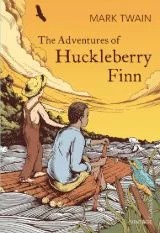Anna Karenina by Leo Tolsto...
Count Lev Nikolayevich Tolstoy, or Leo Tolsto...
By Susan Giles1396

0

Mark Twain’s The Adventures of Huckleberry Finn is a must-read for every child and adult out there. A classic that was published over a century ago, in 1885 to be exact, this book is a sequel to The Adventures of Tom Sawyer, which is another critically acclaimed book by the accomplished writer.
Even though it is a powerful anecdote that tackles several prevalent topics, such as prejudice and racism, some educational institutions overlook its significance and refrain from teaching it to their students.
The story revolves around Huckleberry Finn, a young boy who narrates his own story. Huck, as he is called throughout the book, endures a tough childhood due to his abusive and vile father who locks him up in a shed. Huck tries to escape to make a new and peaceful life for himself.
He manages to run away and commences his journey along the Mississippi River with no destination in mind. On his way, he meets Jim, a runaway slave whose family is sold to a plantation. In an attempt to escape the misery, Jim ran away, where he crossed paths with Huck alongside the Mississippi River.
Huck and Jim then live on a nearby island where they discover an abandoned raft and a floating house. A few adventurous gimmicks later, Huck finds himself facing a moral conundrum where he is torn between selling Jim for a few bucks or saving his only friend’s life. Various feats follow, where the two runaways meet crazy families, impersonate brothers, and go on several other striking adventures.
Tom Sawyer’s abrupt introduction halfway through the book is eerily convenient. Some parts of The Adventures of Huckleberry Finn will crack you up, especially the ones revolving around Tom and Huck’s outlandish kidnapping ploy. The final part where everyone gets their happy ending offers a satisfying ending where everything comes together rather conveniently.
The book’s title points to the surprisingly normalized prejudices of society in a satirical and ingenious way. Huck’s adventures portray his encounter with bigotry and several taboos that are sadly common in today’s world. He also subtly showcases the pursuit of the American Dream and the racial intolerance that often stands in the way.
Huck, who is only fourteen years old, is portrayed as a simpleton who honestly narrates his personal analysis of the world around him. His young age makes you sympathize with the character and even forgive some of his foolery.
Twain’s writing style is vernacular and establishes a clear threshold between both centuries. While some writers like to explore new styles and writing formats, others, like Mark Twain, prefer to stick to the familiar. The tone and narration style of the book reflects Huck’s character, who is a naïve and uneducated boy.
Twain’s deliberate use of incorrect grammar and his friendly tone is carefully layered with a vernacular writing style that makes this a one of a kind book and keeps you hooked. The balance between candid and refined narration is impressive, one of the reasons why The Adventures of Huckleberry Finn has received such wide critical acclaim.
All in all, this book is proof of Mark Twain’s unique literary talents. Since this book features certain topics that may spark offense, not everyone can revere or appreciate this classic. But in any case, anyone who deems themself a bibliophile should read this book, at least once, and decide for themselves.
Over the years, The Adventures of Huckleberry Finn has garnered a lot of attention and criticism due to the distasteful representation of black people in America. The mixed reviews may also change your perspective about this book – you will either love it or hate it.
Updated 4 years ago